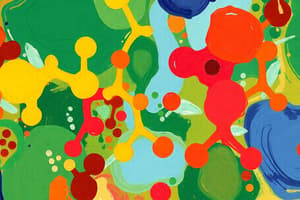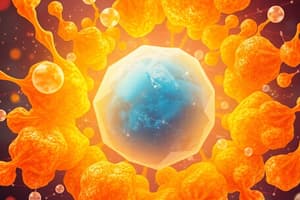Podcast
Questions and Answers
Which of the following is the primary role of insulin in glucose metabolism?
Which of the following is the primary role of insulin in glucose metabolism?
- Inhibiting glucose absorption in the small intestine.
- Stimulating the breakdown of liver glycogen to increase blood glucose levels.
- Lowering blood glucose levels by facilitating glucose uptake into cells. (correct)
- Promoting the synthesis of glucose from non-carbohydrate sources.
A person experiencing nausea, pain, diarrhea, and excessive gas after consuming dairy products most likely has:
A person experiencing nausea, pain, diarrhea, and excessive gas after consuming dairy products most likely has:
- Type 2 diabetes
- Type 1 diabetes
- Hypoglycemia
- Lactose intolerance (correct)
What is the primary storage form of glucose in animals, and where is it mainly stored?
What is the primary storage form of glucose in animals, and where is it mainly stored?
- Fructose, stored in adipose tissue.
- Glycogen, stored in the muscles and liver. (correct)
- Fiber, stored in the intestines.
- Starch, stored in the pancreas.
If someone is on a 2000 calorie diet, what is the recommended Daily Value for fiber intake?
If someone is on a 2000 calorie diet, what is the recommended Daily Value for fiber intake?
Which combination of monosaccharides forms sucrose?
Which combination of monosaccharides forms sucrose?
What are the potential consequences of consuming excessive amounts of fiber?
What are the potential consequences of consuming excessive amounts of fiber?
Which part of the grain kernel is primarily composed of starch and proteins?
Which part of the grain kernel is primarily composed of starch and proteins?
What structural feature distinguishes phospholipids from triglycerides?
What structural feature distinguishes phospholipids from triglycerides?
Which lipoprotein is responsible for transporting cholesterol from the liver to the body's tissues, potentially leading to plaque formation in arteries?
Which lipoprotein is responsible for transporting cholesterol from the liver to the body's tissues, potentially leading to plaque formation in arteries?
Which of the following is a key characteristic that distinguishes saturated fatty acids from unsaturated fatty acids?
Which of the following is a key characteristic that distinguishes saturated fatty acids from unsaturated fatty acids?
How do omega-3 and omega-6 fatty acids exert their functions within the body?
How do omega-3 and omega-6 fatty acids exert their functions within the body?
A person who consumes a diet deficient in omega-3 fatty acids might experience which of the following health issues?
A person who consumes a diet deficient in omega-3 fatty acids might experience which of the following health issues?
What is the primary function of bile in lipid digestion and absorption?
What is the primary function of bile in lipid digestion and absorption?
A complete protein is best described as a protein that:
A complete protein is best described as a protein that:
What is the process by which a protein loses its functional shape due to exposure to heat, acid, or other disruptive conditions?
What is the process by which a protein loses its functional shape due to exposure to heat, acid, or other disruptive conditions?
If a person excretes more nitrogen than they ingest, they are in a state of:
If a person excretes more nitrogen than they ingest, they are in a state of:
Which of the following is a key function of enzymes, which are proteins?
Which of the following is a key function of enzymes, which are proteins?
A vegan diet excludes all animal products, potentially leading to a deficiency in which vitamin, commonly found in animal-sourced foods?
A vegan diet excludes all animal products, potentially leading to a deficiency in which vitamin, commonly found in animal-sourced foods?
Which of the following is a key function of Vitamin K in the body?
Which of the following is a key function of Vitamin K in the body?
Why is Vitamin B12 absorption uniquely dependent on stomach acid and intrinsic factor?
Why is Vitamin B12 absorption uniquely dependent on stomach acid and intrinsic factor?
How does vitamin A support vision?
How does vitamin A support vision?
Why are premature babies at a higher risk of vitamin E deficiency?
Why are premature babies at a higher risk of vitamin E deficiency?
What is the primary role of antioxidants like vitamin C and beta-carotene in protecting cells?
What is the primary role of antioxidants like vitamin C and beta-carotene in protecting cells?
Flashcards
Monosaccharides
Monosaccharides
Single sugar units that are absorbed directly into the blood.
Disaccharides
Disaccharides
Pairs of single sugars linked together, requiring enzymes for digestion.
Polysaccharides
Polysaccharides
Large chains of monosaccharides; includes starch, glycogen, and fiber.
Glycogen
Glycogen
Signup and view all the flashcards
Insulin
Insulin
Signup and view all the flashcards
Glucagon
Glucagon
Signup and view all the flashcards
Lactose Intolerance
Lactose Intolerance
Signup and view all the flashcards
Triglycerides
Triglycerides
Signup and view all the flashcards
Cholesterol
Cholesterol
Signup and view all the flashcards
Transfat: Hydrogenation
Transfat: Hydrogenation
Signup and view all the flashcards
HDL
HDL
Signup and view all the flashcards
LDL
LDL
Signup and view all the flashcards
Essential Fatty Acids
Essential Fatty Acids
Signup and view all the flashcards
Amino Acid
Amino Acid
Signup and view all the flashcards
Essential Amino Acids
Essential Amino Acids
Signup and view all the flashcards
Peptide Bond
Peptide Bond
Signup and view all the flashcards
Enzymes
Enzymes
Signup and view all the flashcards
Urea
Urea
Signup and view all the flashcards
Complete Protein
Complete Protein
Signup and view all the flashcards
Antibodies
Antibodies
Signup and view all the flashcards
Denaturation
Denaturation
Signup and view all the flashcards
Water-Soluble Vitamins
Water-Soluble Vitamins
Signup and view all the flashcards
Fat-Soluble Vitamins
Fat-Soluble Vitamins
Signup and view all the flashcards
Study Notes
Monosaccharides
- Glucose is the most important monosaccharide in the human body
- Monosaccharides are single sugar units absorbed directly into the blood
- Chemical names of sugars end in "ose"
Disaccharides
- Disaccharides are simple carbohydrates
- They consist of pairs of single sugars linked together
- Enzymes digest and break down disaccharides
Types of Disaccharides
- Sucrose is composed of fructose and glucose
- Maltose is composed of two glucose molecules
- Lactose is composed of glucose and galactose
Polysaccharides
- Polysaccharides include starch, glycogen, and fiber
Glycogen
- Glycogen is a key storage form of glucose in animals
- It is stored in muscles and the liver
- Glycogen is nearly undetectable in meats
Fiber
- Fiber is only found in plants, forming leaves, stems, and seeds
Ketosis
- Ketosis involves a high concentration of ketone bodies, which are products of incomplete fat breakdown
Insulin and Glucagon
- Insulin lowers blood glucose levels
- Glucagon facilitates the breakdown of liver glycogen
Blood Glucose Regulation Issues
- Diabetes involves high blood glucose levels
- Hypoglycemia involves low blood glucose levels
Lactose Intolerance
- Lactose intolerance is an impaired ability to digest lactose due to reduced lactase
- Symptoms include nausea, pain, diarrhea, and excessive gas
Carbohydrate Absorption
- Carbohydrates are absorbed into the bloodstream and used for energy
Recommended Fiber Intake
- Men: 38 g/day through age 50; 30 g/day for 51 and up
- Women: 25 g/day through age 50; 21 g/day for 51 and up
- Daily Value: 28 g/day based on a 2000 calorie diet
Recommended Carbohydrate Intake
- RDA: 130 g/day (minimum)
- AMDR: 45% to 65% of total calories
Consequences of Excess Fiber
- Excess fiber can limit the absorption of iron and zinc
Sources of Dietary Fiber
- Grains, fruits, and vegetables are the best sources
Nutrients Added During Enrichment
- Iron, thiamin, riboflavin, and niacin were added in 1942, and folate in 1996
Type 1 Diabetes
- Type 1 diabetes typically diagnosed in childhood, involves blood glucose staying too high due to lack of insulin
Type 2 Diabetes
- Type 2 diabetes, is blood glucose stays too high because cells do not respond to insulin
Grain Kernel Parts
- Germ: rich in oils, vitamins, and minerals
- Endosperm: mostly starch and proteins
- Bran: rich in nutrients and fiber
- Husk: inedible
Lipid Classes
- Triglycerides are the most common lipid in the body
- Phospholipids contains glycerol, two fatty acids, and phosphorus molecule
- Sterols consists of rings of carbon
Cholesterol
- Cholesterol is a sterol and is a component of bile and cell membranes
- The liver manufactures cholesterol
Trans Fat
- Trans fat is made via hydrogenation
Lipoproteins
- HDL (High-Density Lipoproteins) are smaller and denser, packaged with more protein
- LDL (Low-Density Lipoproteins) are larger and lighter, richer in cholesterol, and deliver it to tissues
Lipid Digestion
- Fatty acids split from glycerol in the mouth, stomach, and small intestine
- Bile shuttles lipids across mucus layer in the small intestine
- Gallbladder slows the digestion process
Essential Fatty Acids
- Omega-3 Fatty Acids (α-Linolenic Acid): Found in chia seeds, flaxseed, walnuts, and soybeans
- EPA/DHA: Found in eggs, fish, and seafood, and critical in regulating heart disease, cancer prevention, brain function, and vision
- Omega-6 Fatty Acids (Linoleic Acid): Found in vegetable oils like corn and sunflower and in cashews, walnuts, and poultry fat
Functions of Essential Fatty Acids
- Act as cell signals that modulate cell and tissue function
- Promote normal growth and vision
Purposes of Lipids
- Adipose tissue secretes hormones to regulate appetite
- Lipids act as shock absorbers and insulators
- Help form cell membranes
- Help transport substances
- Provide energy
Blood Lipid Levels
- Total cholesterol: < 200
- LDL cholesterol: < 100
- HDL cholesterol: ≥ 60
- Triglycerides: < 150
Fatty Acids
- Saturated fatty acids have no double bonds
- Monounsaturated fatty acids have one double bond
- Polyunsaturated fatty acids have two or more double bonds
Amino Acids
- Amino acids are molecules that combine to form proteins
- Essential amino acids can only be replenished from foods
- Peptide bonds link amino acids
Hormones
- Hormones are proteins that regulate body processes
Enzymes
- Enzymes are proteins that facilitate chemical reactions
Urea
- Urea is a waste product of protein digestion
Complete vs Incomplete Proteins
- Complete proteins provide enough of all 9 essential amino acids
- Incomplete proteins do not
Celiac Disease
- In celiac disease, gluten triggers abnormal immune responses
Antibodies
- Antibodies are molecules from the immune system that fight diseases
Amino Acid Supplements
- Branched-chain amino acids (BCAA) supplements are available
Wasting Amino Acids
- Lacking energy from other sources causes amino acids to be wasted
- Receiving more proteins than needed/low quality causes amino acids to be wasted
- Too much of any single amino acid causes amino acids to be wasted
Protein Supplements
- Bone broth, collagen, and gelatin are protein supplements
Amino Acid Parts
- Amino acids contain nitrogen, carbon, hydrogen, and oxygen atoms
Denaturation of Proteins
- When a protein molecule loses its shape, it can no longer function
Denaturing Agents
- Heat, alcohol, acids, bases, radiation, and salts of heavy metals can denature proteins
Recommended Daily Protein Intake
- 0.8 grams per kg of body weight
- AMDR is 10-35% of total kcalories
Nitrogen Balance
- Nitrogen balance is the amount of nitrogen excreted compared to nitrogen eaten
- Positive nitrogen balance: Nitrogen-in exceeds nitrogen-out
- Negative nitrogen balance: Nitrogen-out exceeds nitrogen-in
Vegetarian Diets
- Fruitarian: Includes only raw or dried fruits, seeds, and nuts
- Lacto-ovo-vegetarian: Includes dairy products, eggs, vegetables, grains, legumes, fruits, and nuts, but no flesh or seafood
- Lacto-vegetarian: Includes dairy products, vegetables, grains, legumes, fruits, and nuts, but no flesh, seafood, or eggs
- Macrobiotic diet: Primarily whole grains, beans, and certain vegetables; extreme, affecting nutrient status
- Ovo-vegetarian: Includes eggs, vegetables, grains, legumes, fruits, and nuts, but no flesh, seafood, or milk products
- Partial vegetarian (Flexitarian): Includes seafood, poultry, eggs, dairy, vegetables, grains, legumes, fruits, and nuts, but excludes or limits certain meats (e.g., red meats)
Benefits of Vegetarian Diets
- Defense against obesity, heart disease, hypertension, and cancer
- Beneficial impacts during pregnancy and infancy, adolescence, aging, and illness
Vitamins
- Water-soluble: dissolve in water; B vitamins (thiamin, riboflavin, niacin, folate, B12, B6, biotin), and vitamin C
- Fat-soluble: dissolve in fat; vitamins A, D, E, and K
Provitamins
- Provitamins can be converted into a vitamin in the body
Vitamin D Deficiencies
- Rickets: Vitamin D deficiency early in life
- Osteomalacia: Vitamin D deficiency in adults
Niacin Deficiency
- Pellagra: Niacin deficiency, particularly among alcoholics
Folate Deficiency
- Neural Tube Defect: Birth defects when the neural tube does not close completely (e.g., cleft lip)
Thiamin Deficiency
- Beriberi: Thiamin deficiency
Antioxidants
- Antioxidants protect cells from damage caused by free radicals
Prooxidants
- Prooxidants can damage cells by producing reactive oxygen species
Vitamin B12 Absorption
- Requires stomach acid and intrinsic factor for absorption
Functions of Vitamin A
- Eyesight: Healthy cornea
- Night blindness: Deficiency of vitamin A
- Immune function
- Reproduction and growth: Bones, teeth
Functions of Vitamin E
- Antioxidant, guarding against oxidative damage
- Reduced inflammation
Vitamin E Deficiencies
- Occur in people with diseases that cause fat malabsorption
- Premature babies
Functions of Vitamin K
- Blood clotting
- Bone protein synthesis
Vitamin K Deficiencies
- Dangerous in newborns
- Jaundice
- Drug interference
Functions of Vitamin B12
- Coenzymes in cell replication
- Maintains sheaths around nerve fibers
Vitamin B12 Deficiencies
- Anemia
- Presence of large, immature red blood cells
- General malfunctioning of nerves and muscles
Sources of Vitamin C and Beta-Carotene
- Fresh fruits and vegetables, white potatoes, and sweet potatoes
Beta-Carotene
- Dietary antioxidant
- Plant-based foods
Vitamin C Deficiency Symptoms
- Scurvy, more common in alcoholics
Studying That Suits You
Use AI to generate personalized quizzes and flashcards to suit your learning preferences.
Description
This covers the basics of Carbohydrates. It discusses monosaccharides, disaccharides, and polysaccharides, including examples like glucose, sucrose, and starch. It also touches upon glycogen, fiber, ketosis, insulin and glucagon.




